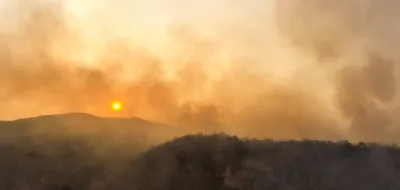Navigating the Challenges and Safeguarding Health
Throughout the past few weeks, Canada has been grappling with uncontrolled wildfires in Quebec and Ontario. While wildfire season in Canada typically occurs from May to August, as this is when the climate is at its hottest and driest, it has been uncommon to see so many devastating fires so early in the summer season. Increased intensity and frequency of these wildfires can be contributed to climate change, indicating that Canada can expect see more uncontrolled wildfires both this season and upcoming seasons.1 When it comes to those living with asthma and COPD, smoke from these wildfires is a major concern when it comes to living everyday life.
Smoke from these wildfires has settled in the air across these provinces and has been carried by the wind as far as the northeastern United States, posing a significant threat to air quality in these regions.2 Wildfire smoke is composed of a wide variety of gaseous pollutants, water vapour, and particle matter (PM). PM is the term used to refer to a mixture of solid and liquid compounds such as chemicals, soot, soil, acid, or dust that are suspended in the air, and is the main component of wildfire smoke. PM also happens to also be the most threatening to public health.
Impact of Wildfire Smoke on Asthma, Triggers and Symptoms
PM is inhaled every single day, but just not always in high volumes. However, since there is a high concentration of PM in wildfire smoke, the amount of PM inhaled increases significantly during a wildfire that deposits smoke in the air.3 Inhaling increased levels of PM can worsen symptoms of asthma. These worsened symptoms, as well as general symptoms of increased PM inhalation, include:4
- Increased coughing
- Increased chest discomfort
- Wheezing
- Increased frequency and intensity of asthma attacks
- Shortness of breath
- Headaches
- Irritated throat, eyes, and sinuses
Mitigating Asthma Risks during Wildfires
There are multiple steps those with asthma can take to avoid worsening symptoms and triggers during wildfires. Firstly, asthma sufferers should stay informed and monitor air quality. Air Quality Health Indexes (AQHI) assess air quality and are a reliable measure to help you understand what the air quality around you is and what it means to your health.5 The AQHIs can be accessed by downloading smartphone apps, visiting AQHI websites, or checking select weather apps, thus making information about air-quality available to you in real time.
Asthma sufferers should prioritize the establishment of a clean indoor environment, as fine particulate matter (PM) can easily infiltrate homes and linger for prolonged periods, leading to heightened asthma symptoms even while indoors.6 Keep all windows and doors closed to prevent smoke from entering your house and getting trapped. Additionally, use air purifiers with HEPA filters to improve indoor air quality. HEPA air filters trap fine, harmful particles from the air in a single room, thus increasing indoor air quality.7
For individuals with asthma, prioritizing additional precautions becomes crucial when engaging in outdoor work. When AQHIs indicate that it is unhealthy for people with respiratory conditions to go outside, you should consider limiting outdoor activities and find alternatives inside whenever possible, especially during wildfire season. When outside activity cannot be avoided, a NIOSH-certified mask, such as an N95 respirator, should be used. NIOSH-certified masks are very effective in filtering out find PM2.5 particles from inhaled air, making it suitable for wear in air polluted by wildfire smoke.8
If you or a loved one struggle with asthma, consider consulting with your healthcare provider to develop a personalized asthma action plan. An asthma action plan is a written plan that identifies which allergens and irritants to avoid, how to identify an asthma attack and a contingency plan, which medicines should be taken during an attack and how to take them, when to call a doctor or go to the emergency room, and who to contact in the case of an attack.9
Enhanced Asthma Relief during Wildfire Season
Optimizing medication delivery is crucial for effective asthma management, especially during the challenging wildfire season. One essential aspect is using a controller inhaler, which provides long-term management and reduces asthma symptoms. To further enhance the effectiveness of the controller inhaler, incorporating a spacer device, such as an AEROCHAMBER* Chamber at home and an AEROCHAMBER2GO* Chamber on the go, can improve medication delivery to the lungs.
By utilizing spacer devices like the AEROCHAMBER* Chamber and AEROCHAMBER2GO* Chamber, you can take proactive steps to optimize medication delivery and achieve better asthma control. With the combination of a controller inhaler and a spacer device, you can effectively manage your asthma, reduce symptoms, and improve your overall respiratory well-being during wildfire season and beyond.
